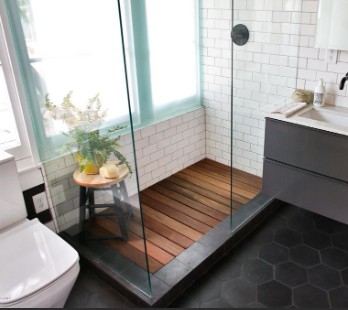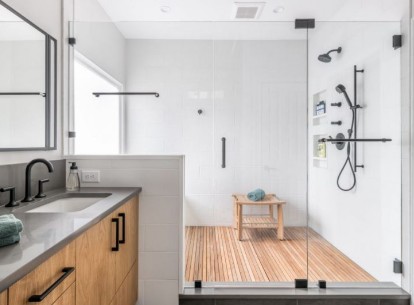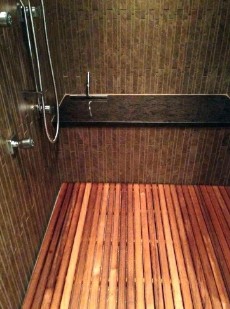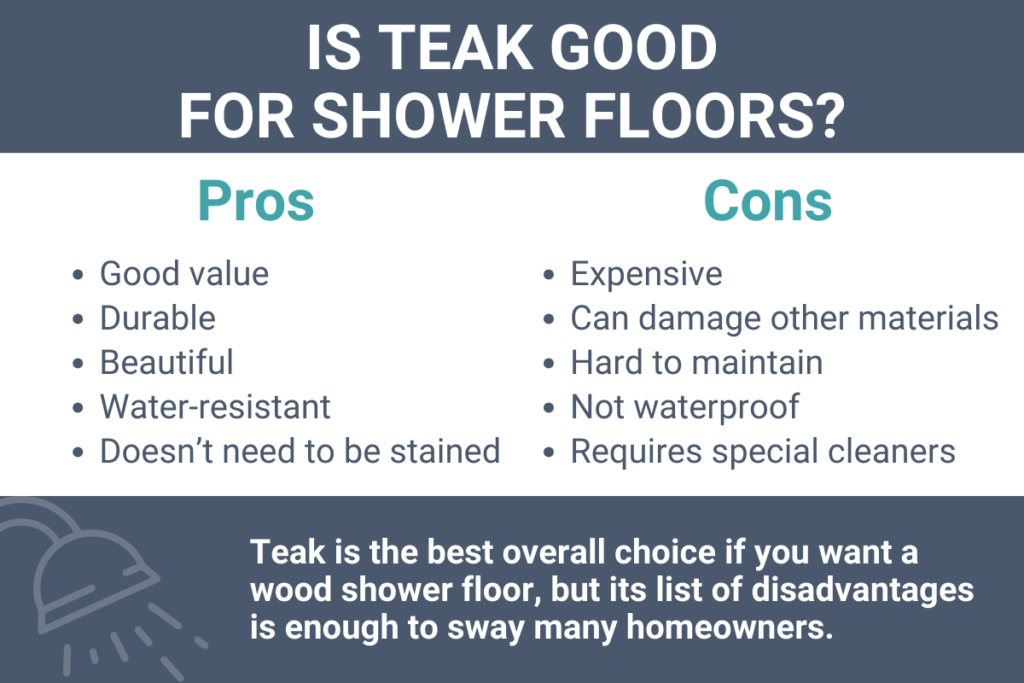Teak Shower Floor Pros and Cons Explained (Read This First!)
It may not be the obvious choice, but certain woods can add beauty and personality to your bathroom. Teak can be used in place of tile in some cases, but have you considered the teak shower floor pros and cons?
The pros of teak shower floors are that they are beautiful, durable, water-resistant, comfortable, and resistant to fungi, mold, pests, and water. However, the downside is they aren’t entirely waterproof, are expensive, leave room for bacteria, and can damage other materials. Teak also requires regular maintenance to keep it in good condition.
Keep reading to find out all the pros and cons of teak shower floors, plus tips on how to install, polish, and clean a teak shower floor and potential wood floor alternatives.
Is teak good for shower floors – pros and cons overview?
Teak is a tropical hardwood that can be used throughout your home. Is it also good for a shower floor?

Teak is a good choice for adding comfort and personality to your shower floor as it is very durable and is resistant to water damage and mold when cared for properly. However, it is very impressive, requires special care, and will require a standard tile floor to be installed beneath it.
| Pros of a teak shower floor | Cons of a teak shower floor |
|---|---|
| Good value | Expensive |
| Durable | Can damage other materials |
| Beautiful and stylish | Hard to maintain |
| Water-resistant | Not waterproof |
| Doesn’t require varnish or stain | Requires special cleaners |
| Multiple installation methods | Requires flooring beneath it |
| Resistant to pests, mildew, and mold | Allows room for bacterial growth |
| Warm, non-slip, and comfortable | |
| Available in engineered and solid variants |
Keep reading for a complete examination of all of the pros and cons of a teak shower floor.
Teak shower floor pros
Teak is a popular option for homeowners who want their bathrooms to remind them of a nice sauna. Is it right for you? Let’s take a look at the pros of a teak shower floor, then we’ll talk about the cons.

The benefits of teak shower floors include:
- Good value
- Durable
- Beautiful and stylish
- Water-resistant
- Doesn’t require varnish or stain
- Multiple installation methods
- Resistant to pests, mildew, and mold
- Warm, non-slip, and comfortable
- Available in engineered and solid variants
Let’s take a look at each of these pros in detail.
1. Good value
It’s not cheap to install teak in your bathroom, but most people agree you get your money’s worth.
Teak is commonly associated with premium construction and luxurious spa accommodations, meaning you’ll be able to see and appreciate the investment you’ve put into your bathroom each time you shower.
The high-quality material coupled with the warm, inviting effect is sure to make you feel like the new shower floor was money well spent.
2. Durable
Teak has a Janka Hardness Rating of 1000 to 1155, making it tougher than walnut, maple, and poplar.
Teak is a long-lasting wood floor material that can tolerate extreme heat and cold, making it ideal for areas with hot water or high traffic.
Furthermore, teak is scratch-resistant; it can handle the brutality of your pet’s nails.
3. Beautiful and stylish
If you choose a teak shower floor, you will have one of the most beautiful hardwood bathroom floors – provided you maintain it properly.
Teak’s uniform grain and rich green hue give it a lux appearance and make it ideal for a variety of bathroom designs.
Since it comes in distinct styles and finishes, you can match it with many bathroom furnishings. Teak’s natural finish, for example, is ideal for rustic aesthetics, while darker colors suit modern and striking bathrooms.
4. Water-resistant
Teak is inherently water-resistant, making it the preferred flooring material for bathrooms, kitchens, and mudrooms.
Teak wood is very impervious to water because of its organic oils, which makes it endure longer. When subjected to moisture, it does not swell or bend.
Teak is also resistant to mildew and mold because of its water-resistant characteristics. If you leave it untreated, it will not create a breeding habitat for any fungus.
Furthermore, because water cannot penetrate, it seldom rots.
5. Doesn’t require varnish or stain
While most woods require varnish or stain to protect from damage or mildew, teak is ready to use almost immediately.
Teak floor is that it does not require staining or varnishing. You don’t even need to sand as the extraordinarily long grains resist splintering.
Teak is shiny all the time, with or without stain or varnish, because of its high natural oil content.
6. Multiple installation methods
Teak offers multiple installation methods, depending on your needs and expertise level.
Teak offers two configuration options:
- Nail, staple, or glue it to the subfloor; or
- Float it like snap-together tile flooring.
The former is more costly but provides a more lasting solution. The latter is cheaper and speedier but has room for warping and buckling caused by changes in humidity and temperature in the building.
7. Warm, non-slip, and comfortable
One of the great advantages of choosing a teak shower floor is how surprisingly comfortable it is.
Wood holds heat for an extended period than other forms of flooring, like pebble and tile shower floors. Moreover, it’s also less slippery than tiles when wet.
In addition, teak shower floors are also more soothing on the feet, especially when not wearing shoes.
8. Resistant to pests, mildew, and mold
Teak’s water resistance also means it’s less likely to develop any of the common problems associated with water buildup in bathrooms.
Pests such as fleas, termites, cockroaches, and other insects hardly meddle with teak wood because they cannot penetrate or gnaw on it.
It is also resistant to fungus and mold in damp environments like the restroom.
9. Available in engineered and solid variants
Teak is a costly exotic wood.
Engineered teak flooring with less teak is becoming increasingly popular, particularly among those on a budget for bathroom renovations.
Although it is not necessarily as high quality as solid teak, the engineered option can give you the look and feel without breaking the bank.
Teak shower floor cons
Unfortunately, teak shower floors aren’t without their drawbacks.
Cons of teak shower floors include:
- Expensive
- Can damage other materials
- Hard to maintain
- Not waterproof
- Requires special cleaners
- Requires flooring beneath it
- Allows room for bacterial growth
Let’s take a look at each of these so you can determine whether or not it’s worth proceeding with your dream of a teak shower floor.
1. Expensive
Teak trees take a long time to grow and the forests are heavily regulated. It is often difficult to obtain and this drives up the price.
Teak production is severely limited while demand is high due to its high quality and water resistance, making it very expensive.
If you are on a limited budget, seek cheaper options.
2. Can damage other materials
Teak’s durability can also have a downside.
Teak is a tough wood and can actually do damage to other elements of your bathroom if you’re not careful.
Teak wood can scratch other materials like acrylic tiles, which can be expensive to repair.
3. Hard to maintain
Teak is a beautiful, glossy wood even without varnish or wood stain – but only if you maintain it properly.
To secure the glossy condition of your teak floor for an extended period, you must polish it regularly. You will also need to clean it daily to prevent stains created by shampoo, soap, and other cleaners you may use during your shower.
These chores take a long time to do and might be tiresome. Traditional bathroom cleansers are too abrasive on the wood, so you’ll need to use particular cleaners.
4. Not waterproof
Teak wood is water-resistant but not entirely waterproof.
Water can seep in and cause damage if the wood is not cared for regularly.
It is also possible for water to penetrate to the next level and become trapped, damaging the subfloor.
5. Requires special cleaners
Teak will shed a fraction of its oils with time, dulling its inherent gloss.
You can delay or even stop the process by cleaning the wood regularly and applying oil to the shower flooring every two years.
Although teak oil is an efficient way to preserve your floor aesthetic, some people do not want to invest time and money in maintaining the shower floor.
6. Requires flooring beneath it
Teak floors are often formed by arranging wood slats into a grid to allow for easy cleaning and evaporation rather than as a slab.
Most teak shower floors will require a tiling to be laid beneath it in order to protect the subfloor from damage.
Even though teak is water resistant, it’s not fully sealed, which means the space beneath it will be susceptible to damage.
How to clean a teak shower floor?
Cleaning and maintaining your teak shower floor is vital to preserving the beauty and function of your investment.
To care for a teak shower floor, you should clean it weekly. Gently scrub the floor with a mild soap solution using a soft-bristled brush. Rinse with clean water and allow to dry.
Vinegar can be used to remove stubborn spots.
How to polish a teak shower floor
Teak shower floors need regular cleaning and polishing to sustain their appearance and longevity.
Start by cleaning the floor completely with a soft-bristled brush and mild soap, then rinse and allow to dry completely.
To polish a teak shower floor:
- Apply teak oil to the teak shower floor with a brush and ensure you cover the whole surface.
- Allow the oil to soak in for 2 hours.
- Polish the teak wood in tiny circles with a dry-cleaning brush until it shines.
Clean and polish the floor whenever you realize it has lost its luster. With good cleaning and upkeep, teak wood in the bathroom may last 10-15 years before needing to be replaced.

How to Install a teak shower floor
Laying a teak shower floor is a breeze if you have the right tools and materials and follow the recommended steps. You can purchase teak wood boards for cutting or ready-made teak wood slats for the shower.
Follow these steps to lay teak wood floors:
- Measure the shower floor – Measure twice, cut once!
- Make a plan – Teak shower floors should be an inch less than the bathroom floor to allow room for expansion.
- Cut the wood – Cut all the pieces you’ll need, including two or three reinforcements of similar size.
- Secure the slats to the bracing boards – Arrange the bracing boards uniformly on the shower floor, then add the wooden slats atop. Check that the slats are a half-inch apart and half-inch from the bathroom wall on both sides. Screw the wooden slats to the reinforcing boards.
Wood alternatives to teak shower floors
Teak is an ideal choice if you want a wood shower floor, but it can be incredibly hard to source and is often prohibitively expensive.
If you’d like the look and feel of a wood shower floor without using teak, here are some alternatives:
- Bamboo – More sustainable and less expensive than teak, bamboo is an anti-bacterial grass. It is not as water resistant as teak and can’t handle as much weight. Consider a bamboo shower mat or bench for the lux look you want.
- Cedar – Cedar is less expensive than teak and just as beautiful. This wood will need to be stained, but that gives you a range of wood tones to complement any style. It is water resistant but will show signs of damage in 5-10 years if not maintained properly.
- Hinoki – This Japanese wood is naturally water-resistant and is a popular choice for saunas. However, it requires daily maintenance, and some owners claim that mold and mildew are inevitable even with regular cleaning. Treated Hinoki tubs are available if you’re willing to trade your shower for a bath.
- White oak – White oak is an extremely hard wood and is more water-resistant than other woods. While not an ideal choice for the shower floor itself, it can be used in the bathroom to add a beautiful look without worrying about rot.
As you can see, teak is the best option for a wood shower floor, but there are many great choices if you’re interested in adding the warmth and style of wood to your bathroom.
Summary of the pros and cons of a teak shower floor
Teak is a long-lasting and beautiful material that creates a stylish shower floor; however, it is not without its disadvantages.

Teak is a naturally beautiful, durable, and water-resistant wood that doesn’t need to be stained or varnished. It is warmer and more comfortable than tile and creates a non-slip surface in your shower. Due to its water resistance, it is also more resistant to pests, mildew, and mold than most wood floor options.
On the other hand, teak is also extremely expensive and so hard that it can actually scratch or otherwise damage the tile beneath it. It must be cleaned weekly and will need to be re-oiled every year or two. Most teak floors also require a full tile floor to be installed beneath them to protect the subfloor.
Is teak good for shower floors?
Teak is the best choice as far as quality if you want a wood shower floor. Unfortunately, it is also very expensive and can be difficult to properly maintain.
Will teak wood mold in the shower?
While teak is resistant to mold and bacteria, it is still possible for the soap residue left in your shower to develop mold. This is why weekly cleaning is so important.
Is teak slippery when wet?
Because it doesn’t need to be sanded, teak is considered slip-resistant. It is also not stained or varnished, meaning there is nothing making the wood more slippery than it would be naturally.
How do you get mold out of teak?
While it’s less likely than in other woods, mold can still develop in teak. To remove it, scrub gently with a 1:1 mixture of bleach and warm water.
Let Us Know How We’re Doing!
Did this expertly prepared resource answer your question?
Do you have another question about home maintenance, home improvement projects, home appliance repair, or something else?
Get more information, send in questions and keep the discussion going by contacting the I’ll Just Fix It Myself company customer service team at at 1-800-928-1490 or Email us at [email protected]
